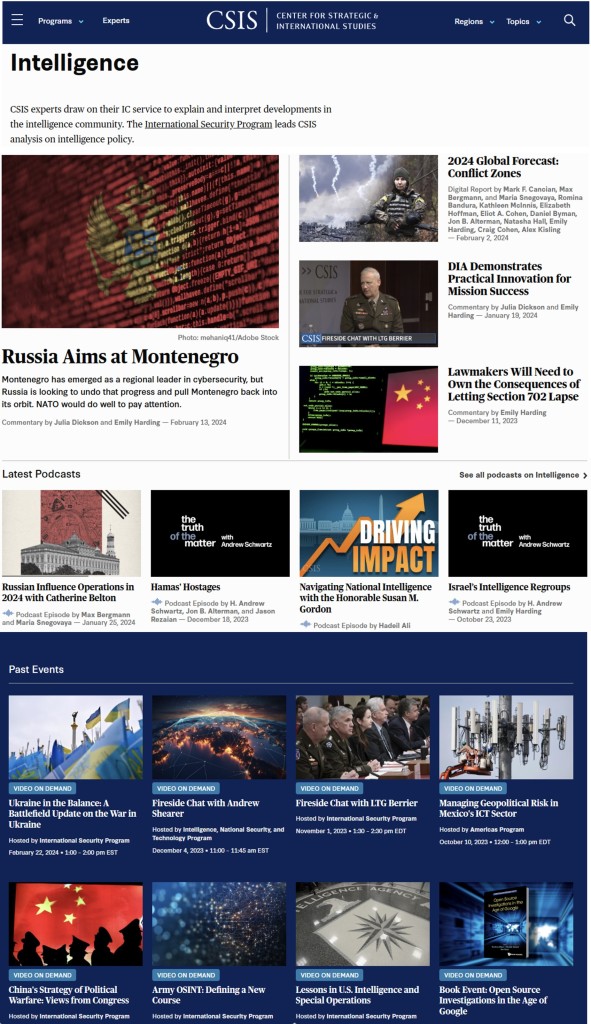For years I’ve enjoyed volunteering on national-security-focused “public/private partnership” projects with colleagues at AFCEA, where I serve on the executive committee of the Board of Directors. But as the Chair of the AFCEA Intelligence Committee, I also have the privilege of overseeing that Committee’s selection of the recipient of a most prestigious annual honor: The Charlie Allen Award for Distinguished Intelligence Service.
Candidates for this award must demonstrate a truly “long and distinguished record of significant accomplishments and senior leadership in support of the Intelligence Community at the national and/or international level,” befitting an award named to honor a legend himself. Charlie served as a senior government executive for over 25 years – during a career of nearly 60 years of total service – with extensive experience in managing the most sensitive programs, heading intelligence collection at CIA, and overseeing large national-system and compartmented acquisition. Since retiring from active government service, Charlie continues to serve the nation in a variety of ways, including as an active member of our AFCEA Intelligence Committee.
The Allen Awardees stretching back to 2009 (and before it was named for Charlie Allen back to 1990 listed here) represent a true pantheon of modern American intelligence. I enjoyed handing the Award last year to a longtime friend and colleague, the then just-retiring-from CIA Dawn Meyerriecks, who capped a stellar career in industrial R&D and DoD by serving as CIA’s “DD/S&T” or Deputy Director of CIA for Science and Technology, long considered “the most powerful development and engineering organization in the IC.”
Later this month I’ll be handing the 2024 Allen Award to John Hamre, President and CEO of the preeminent U.S. national-security think-tank CSIS, the Center for Strategic and International Studies. His official bio is here, but our Committee based its vote on his intelligence contributions specifically, which for two decades at bipartisan CSIS have been extraordinarily rich (read more about the center’s related work here). He’s also spent decades on the boards of IC partners Leidos, SAIC, MITRE, and before that as Deputy Secretary of Defense itself – and as anyone who can read the federal budget knows, the bulk of US intelligence resides within DoD. Several of his most significant decisions in that role remain classified, but a number of our members spoke of them highly in support.
Since leaving the government Dr. Hamre has repeatedly answered a call for continuing service. In 2007, Secretary of Defense Gates appointed him to serve as chairman of the Defense Policy Board, and he served in that capacity for four secretaries of defense. Presiding over a board with Henry Kissinger, James Schlesinger, Brent Scowcroft, Graham Allison and a raft of senior defense and intelligence leaders, Hamre advocated a wide range of innovative management initiatives and clearance reform. In 2008 – 2009, he served on the Secretary of Defense Task Force on DoD Nuclear Weapons Management (“The Schlesinger Panel”), producing a comprehensive report on nuclear deterrence and effectiveness, spending, organization, procedures, mishaps and accidents, and recommendations. Hamre was also principal co-author of the landmark “Science and Security in the 21st Century,” the report of a Secretary of Energy Commission tasked to assess counterintelligence and cyber threats to premier scientific institutions; its lessons continue to echo.
Dr. Hamre received his PhD with distinction in 1978 from the Johns Hopkins School of Advanced International Studies, after a 1972 BA with high distinction from Augustana College in Sioux Falls, SD, in political science and economics. He also spent a year as a Rockefeller Fellow at the Harvard Divinity School. And, finally, he is a longtime friend to AFCEA; I believe one of his earliest AFCEA interactions was an ahead-of-its-time talk at the 1991 AFCEA WEST Conference, on “New Directions for C4I.” I eagerly anticipate him extending that career arc this month at our classified AFCEA Spring Intelligence Symposium, where as the Allen Awardee he will be delivering substantive remarks on a particular topic. Congratulations John Hamre!
Visit here for more information and the full agenda of the 2024 AFCEA Spring Intelligence Symposium (Classified TS/SI/TK, registration closes March 10!).
Filed under: Technology | Tagged: CIA, history, news, politics, USA | Leave a comment »











 But – my favorite – you’ll get to hear a high-intelligence-wattage panel I’m moderating on “Artificial Intelligence, Deep Learning and Machine Augmentation.” When we began planning that panel, I hoped to achieve representation from Academia’s research world, the Intelligence Community, DoD’s increasingly energetic AI sector, and from leading Industry – not a simple task given the classification level. Shockingly, we scored on all four corners of the national security landscape. Here’s that panel:
But – my favorite – you’ll get to hear a high-intelligence-wattage panel I’m moderating on “Artificial Intelligence, Deep Learning and Machine Augmentation.” When we began planning that panel, I hoped to achieve representation from Academia’s research world, the Intelligence Community, DoD’s increasingly energetic AI sector, and from leading Industry – not a simple task given the classification level. Shockingly, we scored on all four corners of the national security landscape. Here’s that panel: d walked many times on the sidewalk by
d walked many times on the sidewalk by 
 at Intel, was its first-ever CTO and the father of the fabled -486 processor. But today he’s virtualizing the world’s computational resources, and Pat tweeted his response to a CNBC anchor’s comments about the Intel CEO job: “I love being CEO of VMware and not going anywhere else. The future is software!”
at Intel, was its first-ever CTO and the father of the fabled -486 processor. But today he’s virtualizing the world’s computational resources, and Pat tweeted his response to a CNBC anchor’s comments about the Intel CEO job: “I love being CEO of VMware and not going anywhere else. The future is software!”